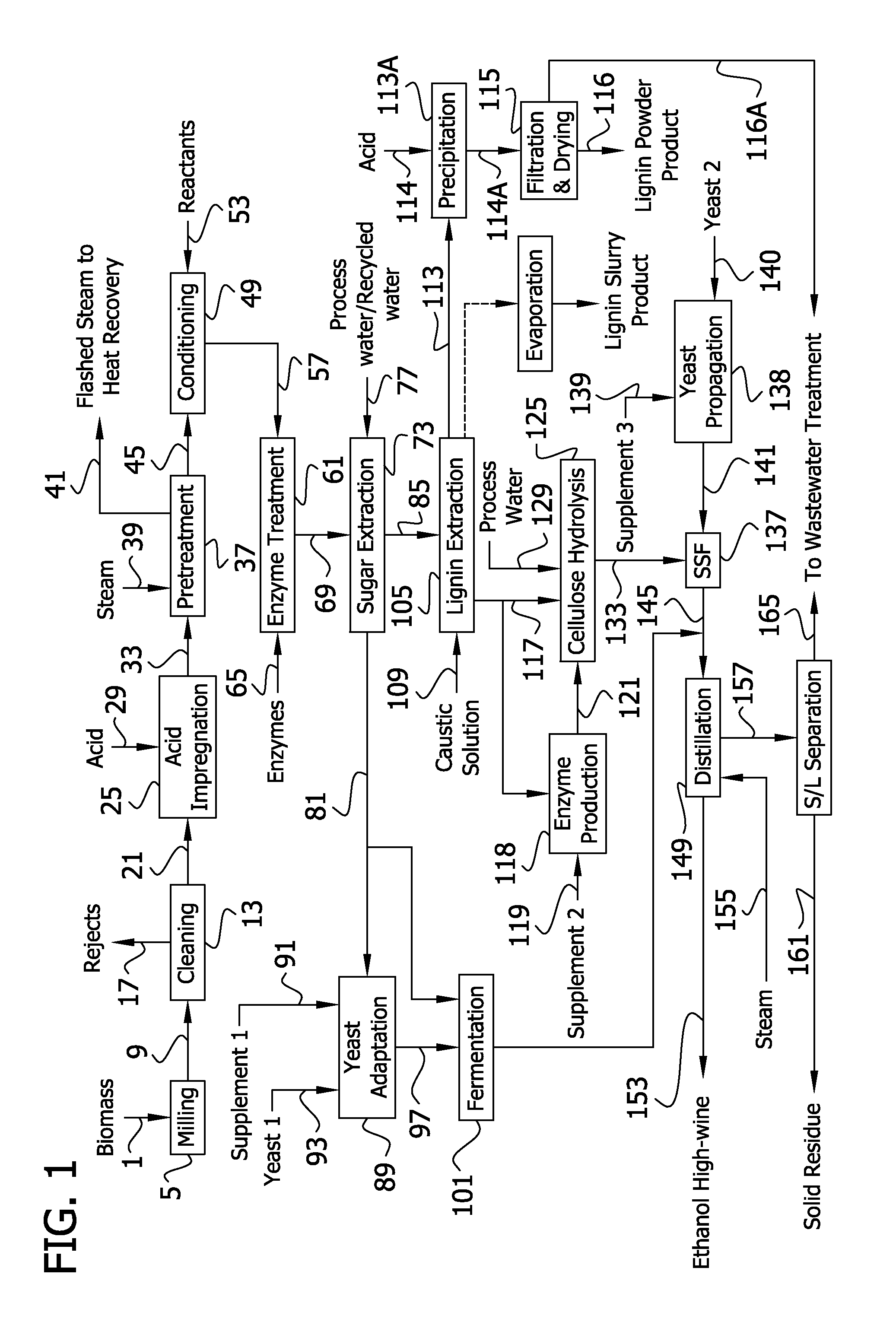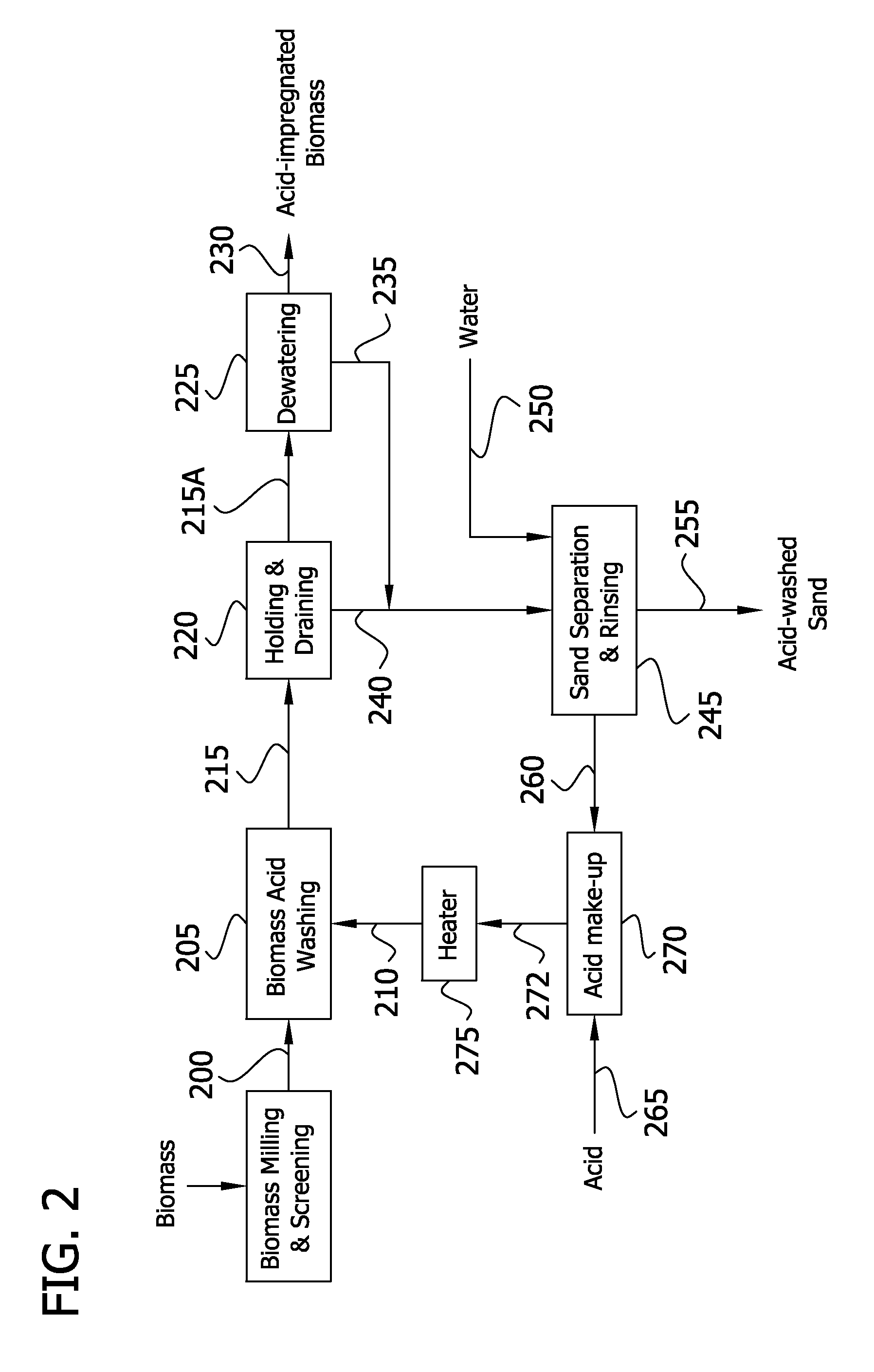Method for producing ethanol and co-products from cellulosic biomass
a cellulosic biomass and co-product technology, applied in the field of cellulosic biomass production processes, can solve the problem of unfulfilled need for ethanol production process, and achieve the effect of improving co-products and improving ethanol yield
- Summary
- Abstract
- Description
- Claims
- Application Information
AI Technical Summary
Benefits of technology
Problems solved by technology
Method used
Image
Examples
example 1
[0311]This example details acid impregnation of corn stover (CS) harvested near Hugoton, Kans. A bale of corn stover weighing approximately 700 pounds was manually de-stringed and introduced into a tub grinder (Vermeer Corporation, Pella, Iowa, U.S.A., Model TG 7000) including a screen having openings of approximately 3 inches to provide coarsely milled feedstock. The coarsely milled corn stover was then milled through a 0.5-inch screen using a hammer mill (Bliss Industrial Inc., Ponca City, Okla. U.S.A., Model ER-2215-TF. The milled corn stover had a moisture content of approximately 11 wt %.
[0312]Following milling, 20 lb batches of the 0.5 inch milled corn stover were impregnated with sulfuric acid. For acid impregnation, the batches of corn stover were tumbled in a 70° C. jacketed double-shaft mixer while approximately 20 lb of a 3% (w / w) solution of sulfuric acid at a temperature of 70° C. was sprayed onto the milled feedstock for a period of 2 minutes. After spraying was comple...
example 2
[0321]This example details power input required during acid impregnation carried out as described in Example 1.
[0322]Power input ranged from 1.7 to 8.5 kWh / ton of corn stover for 2 to 10 minutes mixing time. (Mixing power input =mixing power with straw and acid minus mixing power without corn stover) Acid impregnation mixing time ranged from 4 to 6 minutes, which corresponds to a power input of from 3.4 to 5.1 kWh / ton corn stover (dry weight basis). The moisture content of the milled corn stover was 12 wt % and the moisture content of the acid-impregnated corn stover was approximately 55 wt %. Tables 5 and 6 provide the results for the power input testing.
TABLE 5Estimation of acid impregnation power consumptionRunCS inputPower inputPower iVoltage,Current,time,as is,TS ofDry wtPower consumedper batch ofper ton OperationVAmpminlbCSCS, lbkVAkWper batch, kWhCS, kWhkWhEmpty4601.496200.8817.61.18710.94970.09500.0000N / ACS only4601.856200.8817.61.47391.17910.11790.0229CS plus acid4602.19620...
example 3
[0323]This example provides results of particle size analysis of corn stover pretreated by a variety of combinations of conditions.
[0324]Table 6 provides the results of particle size analysis of milled corn stover using the specified U.S. Standard Sieves. Generally, the particle size distribution of pretreated corn stover is narrower than that of milled corn stover.
TABLE 6AverageStandardSieveOpening, mm / μmretained %Cumulative, %DeviationTray 0.265″6.73mm0.0na0.0Tray #54mm10.81000.7Tray #101.68mm29.289.21.5Tray #20841μm27.7601.4Tray #40420μm14.632.30.6Tray #60250μm4.917.70.8Bottomμm12.812.81.1
[0325]Particle size analysis was conducted for (a) corn stover pretreated at various pressures; (b) water washed corn stover, and (c) fiber recovered from pretreated corn stover stillage. Generally, as described below, at reduced-pressure blow (100 psig vs full-pressure blow at 200 psig), the coarseness increases slightly. Accurately measuring the fiber length for small particles using the Fiber...
PUM
| Property | Measurement | Unit |
|---|---|---|
| Temperature | aaaaa | aaaaa |
| Temperature | aaaaa | aaaaa |
| Temperature | aaaaa | aaaaa |
Abstract
Description
Claims
Application Information
 Login to View More
Login to View More - R&D
- Intellectual Property
- Life Sciences
- Materials
- Tech Scout
- Unparalleled Data Quality
- Higher Quality Content
- 60% Fewer Hallucinations
Browse by: Latest US Patents, China's latest patents, Technical Efficacy Thesaurus, Application Domain, Technology Topic, Popular Technical Reports.
© 2025 PatSnap. All rights reserved.Legal|Privacy policy|Modern Slavery Act Transparency Statement|Sitemap|About US| Contact US: help@patsnap.com



